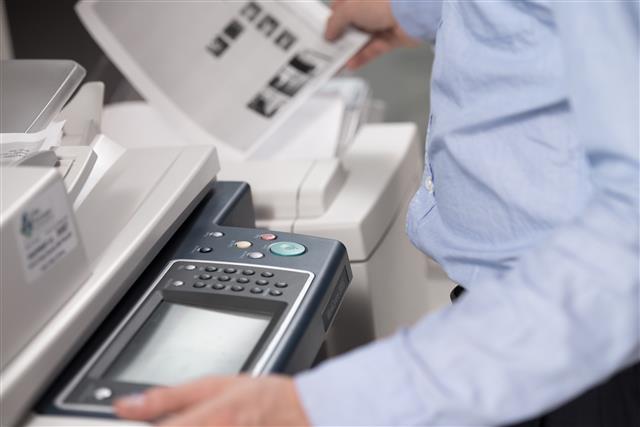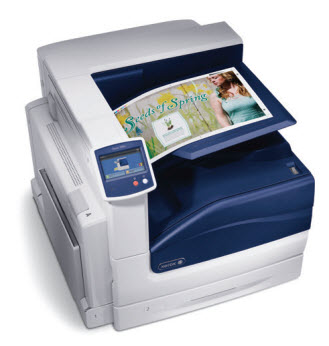There’s more to MPS than break fix and consumables. For further savings and wide-ranging efficiency, print management sets the stage.
Print management typically delivers benefits like these that help organizations:
- Add more print security, control and reporting without disrupting IT infrastructure
- Improve control over print use and costs to drive more savings and meet sustainability goals
- Authenticate users for secure printing anywhere without putting information/data at risk
- Automate data gathering and management to minimize IT burden
- Lay the groundwork for ongoing process improvement with fact-based data
- Guide user behavior changes to use print resources more efficiently
Put print governance in place to support compliance
MPS vendors continually expand and enhance their document and device security solutions to bring customers the best of what’s currently available. Vendors do the research, testing and integration, so enterprises don’t have to. A good example is the recent partner expansion with Y Soft, a leader in intelligent print management. With this expansion of the Xerox® Secure Print Manager Suite, customers gain an affordable option for secure print management that meets the criteria described in this post.
Rising demand for print management has resulted in many more options available on the market. While having lots of choices sounds good, it can be confusing for organizations that need to evaluate and select a good partner. To help, we offer this guide for what to look for in print management solutions, especially those that address information security.
Security: Always Top of the List
Decision makers, especially those in IT, frequently cite security as a top business priority. It’s a must-have versus a value-add requirement. Security is also a critical piece of any print management tool. Before you invest in print management technology, find out if the suite and its security component are compatible with your existing security policies and IT infrastructure to make printing more flexible, secure and responsible, while decreasing costs and waste.
Here’s how print management secures a typical workflow:
To start, a document is automatically sent to the appropriate printer based on job attributes, security parameters or cost. The document is held in a secure, proprietary queue until the user authenticates through a PIN, ID card or network credentials. Once the user is approved, the document is released for printing. No confidential documents lying around in a print tray waiting to be picked up.
Enhance your information security strategy thru better tools to:
- Protect confidential information
- Maintain corporate compliance
- Maintain network security
- Reduce burden on it department
Integration Can Make or Break a Choice
Look for a solution with these network integration capabilities:
- Flexibility allows deployment in any environment, from single-server, single-site locations through multi-server, cross-geographic infrastructures.
- Servers can be located in close proximity to users to ensure performance and ease of management, while tracking and accounting data is uplinked to a centralized reporting engine.
- Support for print servers, direct IP printing or both lets customers set up printing the way that best suits their environment, then adapt easily to changing needs over time.
In addition, get the answers to these questions:
- Can the solution affordably integrate print security, control and reporting without disrupting your existing IT infrastructure?
- Can it integrate into an established IT environment, including existing print and IT vendors, and be implemented at your pace?
Insights and Reporting
When evaluating tools, ask how it gives teams more insight on usage. A good print management tool will analyze and monitor usage and establish print rules that strengthen security, allocate costs and reduce waste. Standard reports for most print management tools are static reports that lack interactive, drill-down reporting.
- Can it gather job-related data for analysis of user behaviors?
- How robust are the reporting options? Does it offer standard as well as customized reports?
- Generated on the fly or scheduled? Delivered via email?
- For recovery purposes, can information be exported to data manipulation or back-end systems in CSV format?
- Does the vendor use a dynamic business intelligence tool to deliver expert analysis on significant cost drivers and inefficiencies?
- Does it require additional software to collect data about how print is created in the organization?
Flexible Choices. Modular Pricing.
Greater print management automation gives you more control over printing processes with less effort. IT teams gain more flexibility to let users print what they need and when they need it, without adding costs and complexities to existing print infrastructure. And your security strategy gets tighter.
How complex is the licensing model? Does it provide flexible licensing in a modular, pay-as-you-go model? A modular approach and usage-based pricing allow enterprises to implement what they need today and easily add or remove modules as their organization grows and changes. Pay only for the software you use, with the ability to add or remove licenses as requirements or print environment changes. Organizations also become more agile, with the option of a flexible, pay-as-you-go model. License charges can be adjusted month to month as devices are either added to or removed from your print environment.
Consider the Xerox® Secure Print Manager Suite powered by Y Soft. Clients only pay for what they use and can scale up or down as needed. Capabilities like print authentication, print roaming, mobile print, scan management, credit and billing and reporting are modular and can be added or not as needed.
Simplicity and Ease of Use
On the print control side, when both server-based printing and direct IP printing are managed with single, centralized tool, it results in greater simplicity and ease of management.
- Does the solution you’re considering let users print what they need and when and where they need it, without adding costs and complexities to existing print infrastructure?
- Can the user and the printer can be anywhere in the network? For example, user can create a document on his laptop at home or at the airport and print it a few hours later when he gets into the office.
Support for Other Solutions and Devices?
Many enterprise print environments are comprised of devices from different vendors, but you want consistent print management across your fleet. Is there only limited support for print devices from other vendors? Purchase of additional job conversion modules for competitive device support adds to your cost and deployment.
Scale: Large and Global, SMB and Local
Some print management tools are architected and licensed to meet the deployment requirements of large organizations. Is this something you’ll need? Be sure to ask.
- What are the data device limits? How many MFPs and printers can the tool handle?
- Will you have to accept limited functionality that relies on print server architecture in every location of branch and remote offices?
- Does it support delegate printing, for example, for an admin authorized to print on behalf of an executive?
Financial Insights into Print Costs and Savings
As the print device is monitored, user activity is tracked and data is collected. The data can be used to generate reports on usage patterns, how much a specific department is printing, how much you’re saving from an environmental perspective and more. You can more clearly see your print costs, which means you can more accurately allocate print charges.
Print management tools augment your MPS results with capabilities like secure document release, chargeback and accounting, and print rules and routing. High-value processes like authentication and job tracking make MPS even more valuable to your organization and your internal customers.
- Does the solution suffer from lack of functionality? Without adequate rules and routing, the tool limits your cost-reduction opportunities.
One More Consideration: Custom or Off-the-Shelf?
Should you choose a custom print management solution or something off-the-shelf? Both have advantages. MPS providers who’ve developed their own may have a cost and pricing advantage, whereas providers offering partner solutions can deliver a robust, fully featured solution independent of device manufacturer.
- Is it a full service offering, or a technology solution that requires investment in skilled IT people and complex setup, configuration and on-going management processes to leverage the toolset?
So many considerations go into a print management choice, it’s valuable to have a partner who can do the evaluation, testing and integration for you. That’s what we did when we chose Y Soft as our print management partner for the Xerox Secure Print Manager Suite.
Print management is about an end-to-end set of services, so it is a complex topic to understand. It’s also an essential part of Next Gen MPS at the level most enterprises need. With the guidance provided here, you’ll be better positioned to make the best choice for your organization. If you’d like to know how the Xerox Secure Print Manager solution compares to these guidelines, learn more here.



